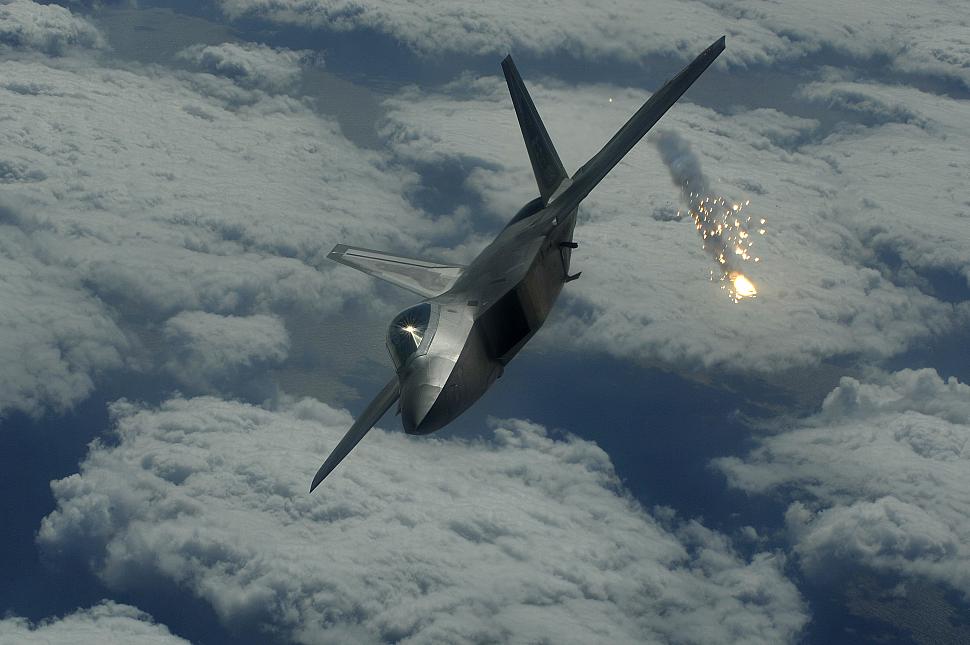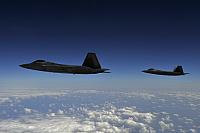Fighter Jet News
F-22 Raptor News
U.S. & Japan conduct bilateral training
March 16, 2009 (by
Walter T. Ham IV) -
This week's bilateral fighter pilot training demonstrates America's commitment to the U.S.-Japan Security Alliance, said the commander of the U.S. Air Force's largest combat wing.

According to 18th Wing Commander, Brig. Gen. Brett Williams, U.S. Airmen regularly conduct joint, combined and bilateral training from Kadena AB to defend Japan and maintain peace and stability in the Asia-Pacific region.
During training sorties March 16 - 19, Japan Air Self Defense Force pilots are practicing defensive missions with the deployed F-22 Raptors from the Langley Air Force Base, Va.-based 27th Expeditionary Fighter Squadron.
"We always welcome the opportunity to train with the JASDF," said General Williams.
Lt. Col. Lansing Pilch, commander of the deployed F-22 squadron, said the reason for the bilateral training with the U.S. Air Force's only stealth fighter is transparent.
"The Raptor is the most advanced fighter in the world," said Colonel Pilch. "The bilateral training restates the U.S. commitment to Japan and to peace and stability in the Pacific region."
Colonel Pilch, who previously flew the F-15 Eagle and F-16 Falcon, is leading the Okinawa deployment of 12 F-22 Raptors and 250 personnel, the second such deployment to the island since February 2007. The colonel said the stealth aircraft is a force multiplier that brings three critical capabilities to the fight.
"First, it is the best fighter in the world at defending an island such as Okinawa. Second, it can strike deep, quickly and precisely like no other fighter," the colonel said. "Finally, the F-22 uses its integrated avionics to pass unprecedented situational awareness to other aircraft. In that way, the F-22 makes every aircraft around it better.
"Each time the F-22 trains with allies such as Japan we make the joint and coalition fighting force more effective," Colonel Pilch said.
To practice defending Japan, 18th Wing fighter pilots routinely train with JASDF fighter squadrons during regularly scheduled Aircraft Relocation Training at JASDF bases in mainland Japan. The 18th Wing also recently conducted bilateral combat search and rescue training during Cope Angel 2009.
Calling the U.S.-Japan alliance a cornerstone of security in the Western Pacific, General Williams also emphasized the importance of Kadena AB as a power projection platform.
"Okinawa is clearly in a strategically important location." the general said. "Our long standing bilateral relations with Japan help us to maintain peace and stability throughout the entire region."
General Williams, an F-15 Eagle pilot with more than 3,600 flight hours, added that bilateral training is the key to maintaining peace.
"To stay ready to fly, fight and win, we must continue to train together," said General Williams. "The surest way to avoid conflicts is to be ready for them."

USAF F-22A block 20 no. 03-4049 shoots out a flare during an air combat training mission on January 15th, 2009. The F-22A is deployed to Kadena AB, Japan from the 27th FS Langley AFB in support of U.S. Pacific Command. [USAF photo by SrA. Clay Lancaster]
During training sorties March 16 - 19, Japan Air Self Defense Force pilots are practicing defensive missions with the deployed F-22 Raptors from the Langley Air Force Base, Va.-based 27th Expeditionary Fighter Squadron.
"We always welcome the opportunity to train with the JASDF," said General Williams.
Lt. Col. Lansing Pilch, commander of the deployed F-22 squadron, said the reason for the bilateral training with the U.S. Air Force's only stealth fighter is transparent.
"The Raptor is the most advanced fighter in the world," said Colonel Pilch. "The bilateral training restates the U.S. commitment to Japan and to peace and stability in the Pacific region."
Colonel Pilch, who previously flew the F-15 Eagle and F-16 Falcon, is leading the Okinawa deployment of 12 F-22 Raptors and 250 personnel, the second such deployment to the island since February 2007. The colonel said the stealth aircraft is a force multiplier that brings three critical capabilities to the fight.
"First, it is the best fighter in the world at defending an island such as Okinawa. Second, it can strike deep, quickly and precisely like no other fighter," the colonel said. "Finally, the F-22 uses its integrated avionics to pass unprecedented situational awareness to other aircraft. In that way, the F-22 makes every aircraft around it better.
"Each time the F-22 trains with allies such as Japan we make the joint and coalition fighting force more effective," Colonel Pilch said.
To practice defending Japan, 18th Wing fighter pilots routinely train with JASDF fighter squadrons during regularly scheduled Aircraft Relocation Training at JASDF bases in mainland Japan. The 18th Wing also recently conducted bilateral combat search and rescue training during Cope Angel 2009.
Calling the U.S.-Japan alliance a cornerstone of security in the Western Pacific, General Williams also emphasized the importance of Kadena AB as a power projection platform.
"Okinawa is clearly in a strategically important location." the general said. "Our long standing bilateral relations with Japan help us to maintain peace and stability throughout the entire region."
General Williams, an F-15 Eagle pilot with more than 3,600 flight hours, added that bilateral training is the key to maintaining peace.
"To stay ready to fly, fight and win, we must continue to train together," said General Williams. "The surest way to avoid conflicts is to be ready for them."
Courtesy of 18th Wing Public Affairs
Related articles:
Forum discussion:
Tags
- Stealth fighter & bomber deployed to Guam for first time ( 2009-03-12)
- F-22A Raptors roaming skies over Okinawa ( 2009-02-03)
- Raptors begin training with 18th Wing ( 2009-01-15)
- Raptors return to the Pacific ( 2009-01-10)
- F-22 Raptor news archive
Forum discussion:
- Start a discussion about this article in the F-22 forum.
Tags


